Abstract
This experimental study attempts to determine if an in-home educational intervention conducted by lay health workers (LHWs) can increase adherence among low-income, inner-city black women to schedules for screening for breast cancer and cervical cancer, as well as increase the women's knowledge and change their attitudes regarding these cancers. This paper is a description of the purposes, hypotheses, design, subject recruitment, intervention, and evaluation of the study conducted by Morehouse School of Medicine. Subjects were recruited from a variety of sources, including patients seen in a community health center, women referred by the National Black Women's Health Project (NBWHP), residents of public and senior citizen housing projects, and persons identified in various community settings. Fewer than half of those asked to participate agreed to do so. The 321 women who were recruited were demographically diverse. Overall, about half of these volunteer subjects self-reported at least one Papanicolaou (Pap) smear and one breast examination within a year before enrollment in the study. There was little variation by source of recruitment in compliance with screening recommendations, except that referrals from NBWHP were more likely (P less than 0.01) to have had a Pap test and breast self-examination, while residents of public housing projects were somewhat less likely to have done so. About 35 percent of participants ages 35 and older had a mammogram within an appropriate interval. Participants were randomly assigned to intervention and control groups. Women in the intervention group were visited in their homes by LHWs on three occasions; the LHWs provided education on cancer and reproductive health.(ABSTRACT TRUNCATED AT 250 WORDS)
Full text
PDF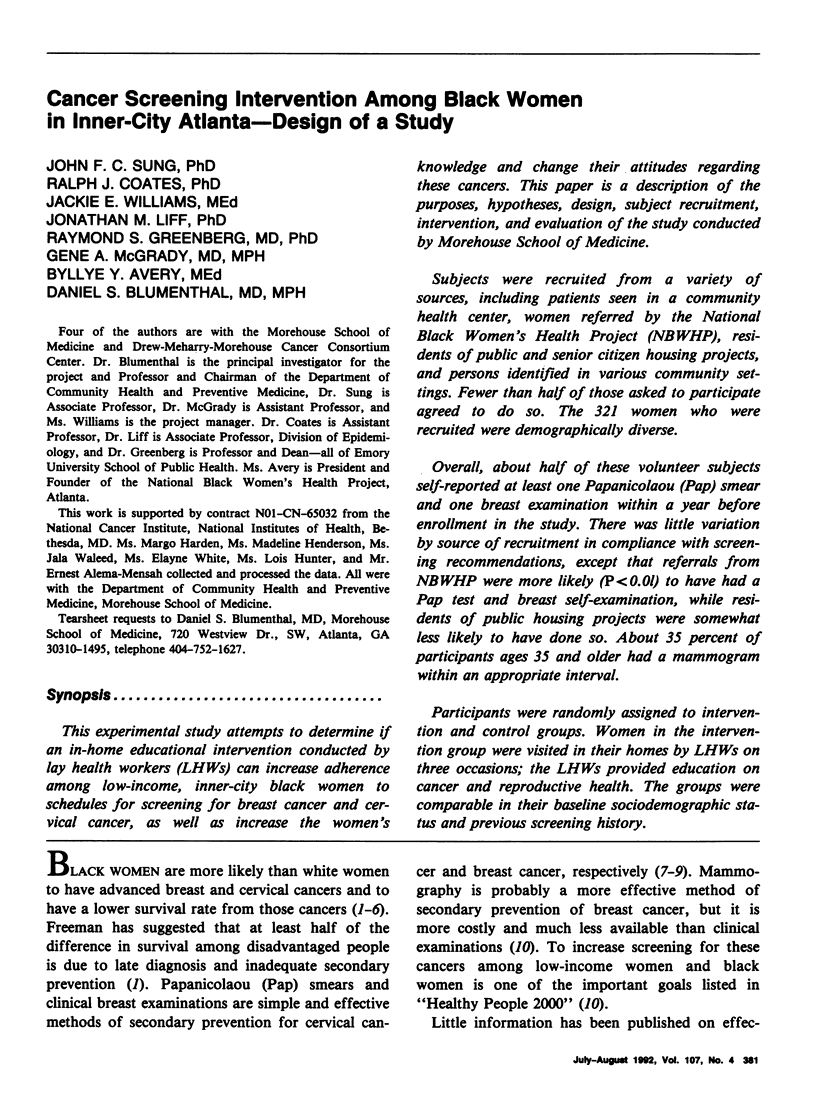
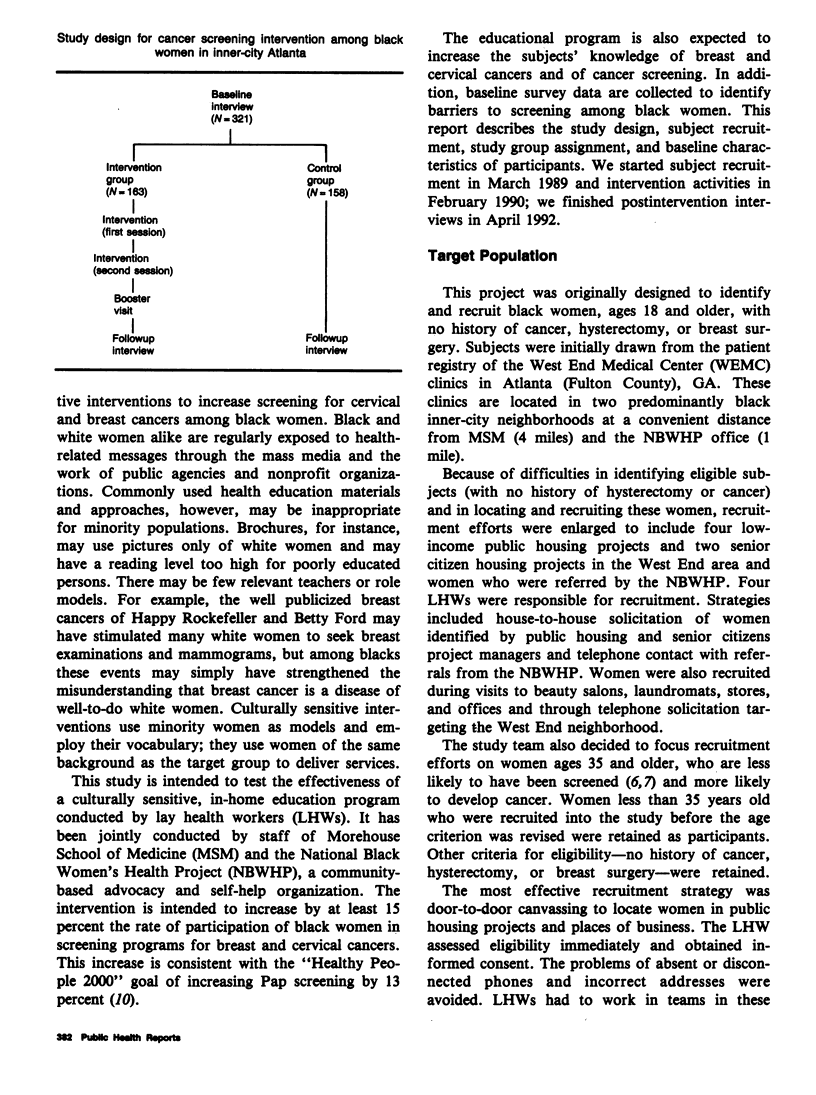
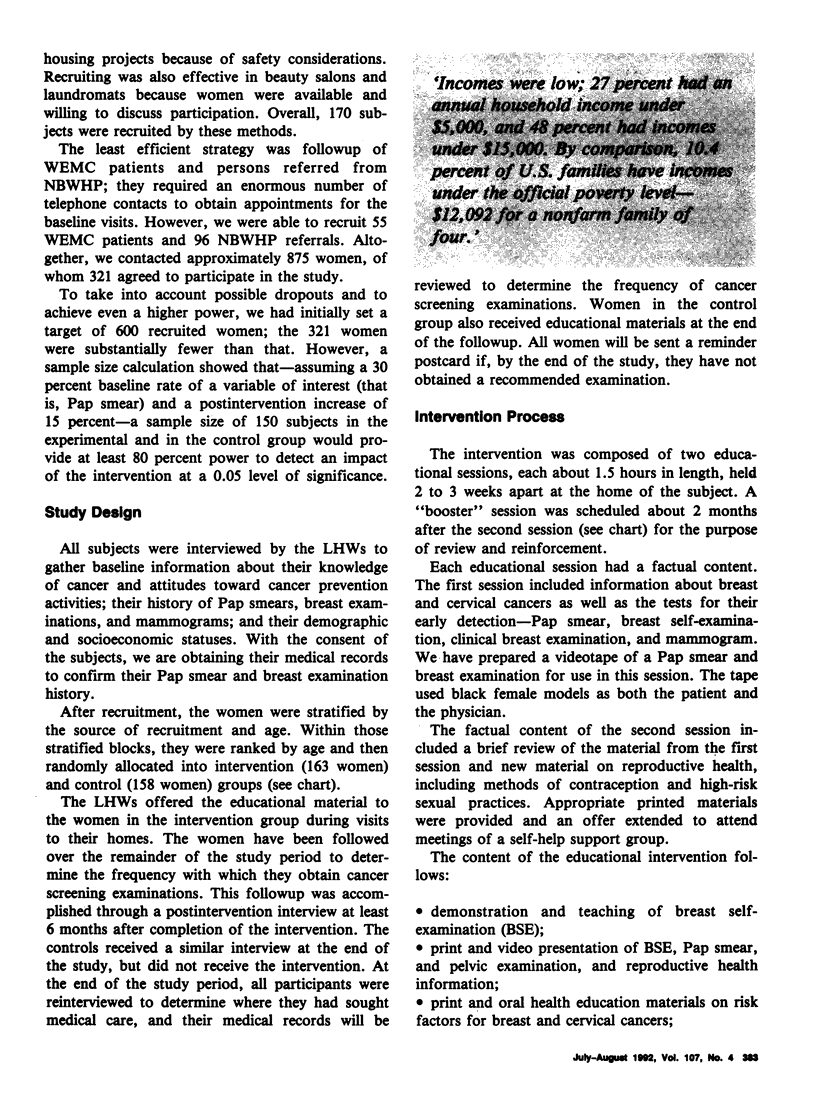
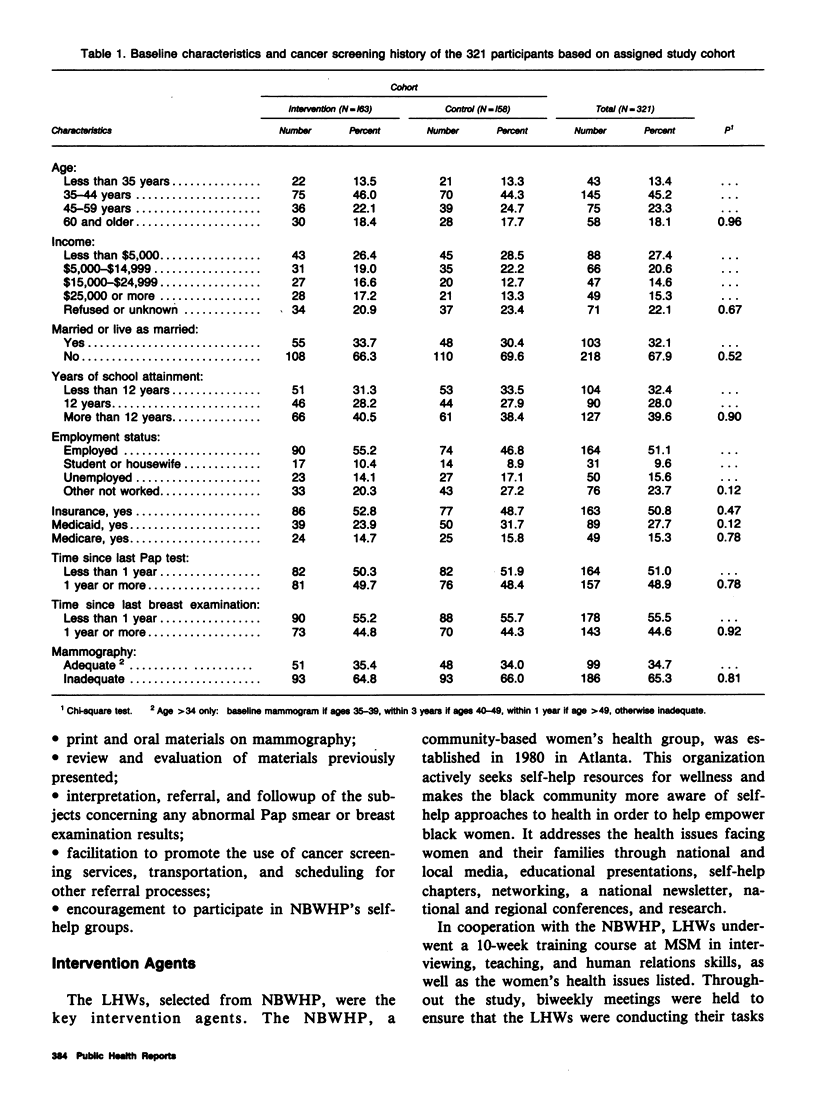
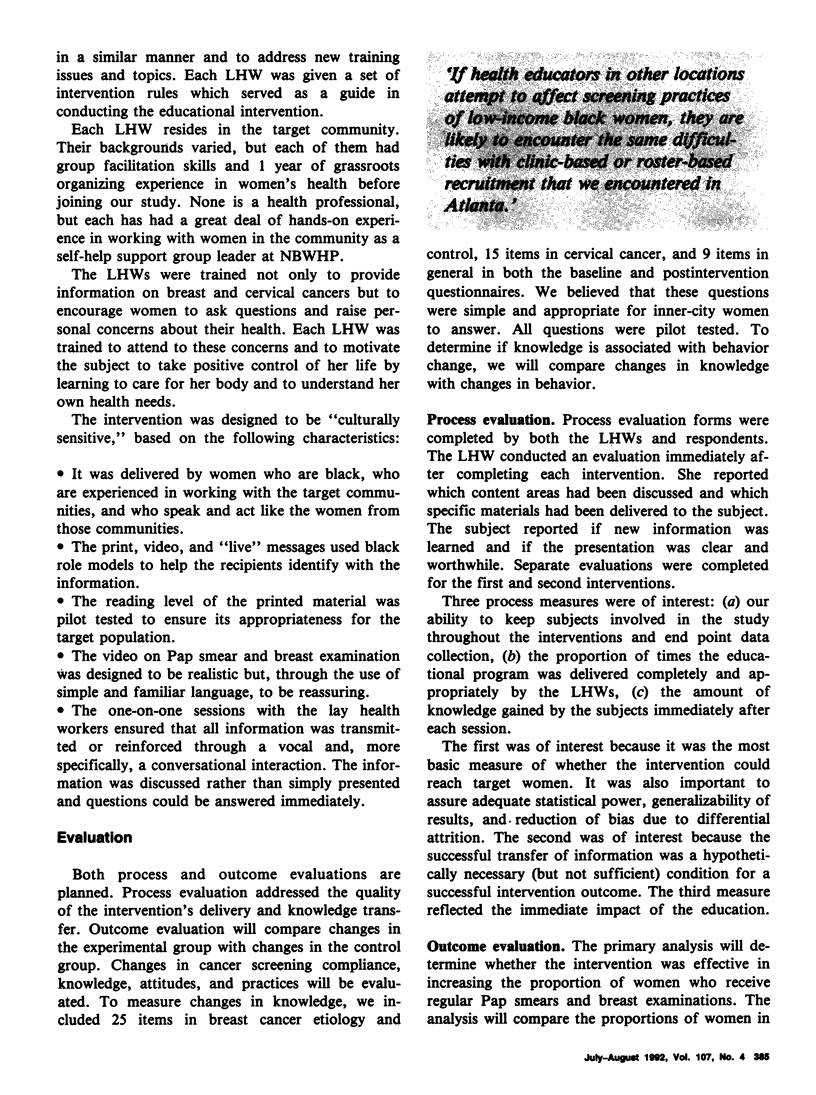


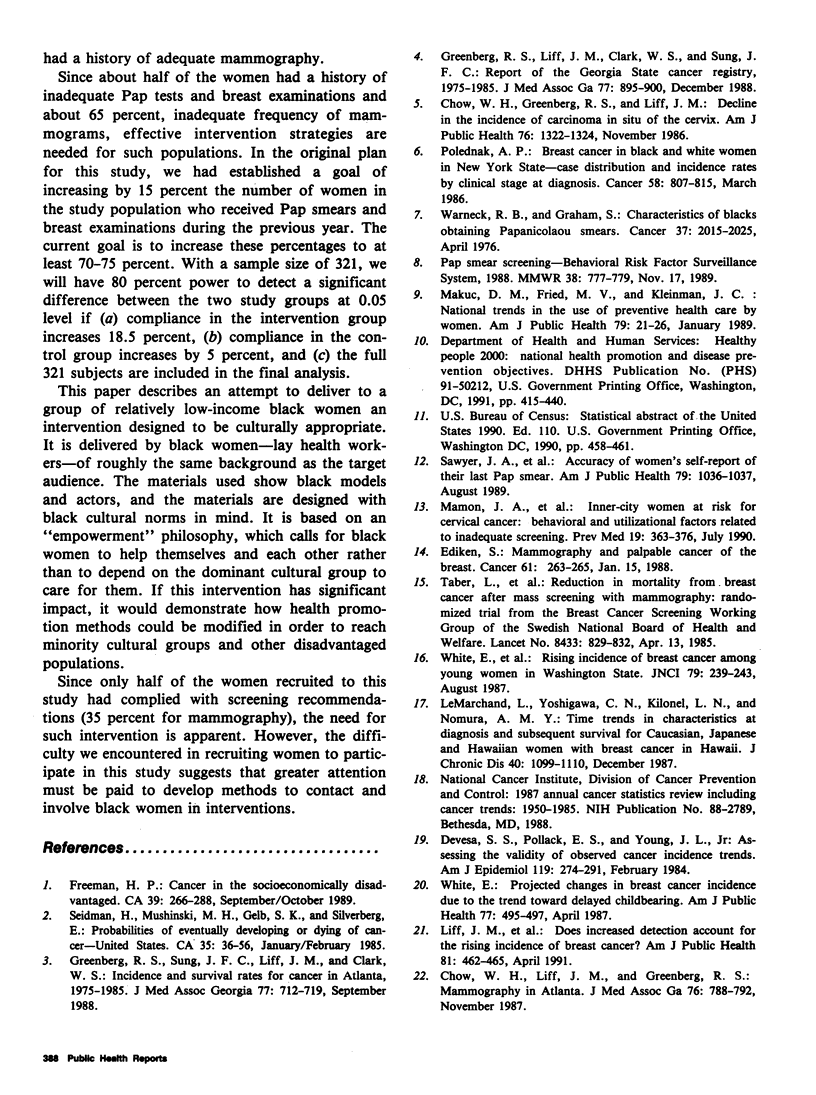
Selected References
These references are in PubMed. This may not be the complete list of references from this article.
- Chow W. H., Greenberg R. S., Liff J. M. Decline in the incidence of carcinoma in situ of the cervix. Am J Public Health. 1986 Nov;76(11):1322–1324. doi: 10.2105/ajph.76.11.1322. [DOI] [PMC free article] [PubMed] [Google Scholar]
- Chow W. H., Liff J. M., Greenberg R. S. Mammography in Atlanta. J Med Assoc Ga. 1987 Nov;76(11):788–792. [PubMed] [Google Scholar]
- Devesa S. S., Pollack E. S., Young J. L., Jr Assessing the validity of observed cancer incidence trends. Am J Epidemiol. 1984 Feb;119(2):274–291. doi: 10.1093/oxfordjournals.aje.a113746. [DOI] [PubMed] [Google Scholar]
- Freeman H. P. Cancer in the socioeconomically disadvantaged. CA Cancer J Clin. 1989 Sep-Oct;39(5):266–288. doi: 10.3322/canjclin.39.5.266. [DOI] [PubMed] [Google Scholar]
- Greenberg R. S., Liff J. M., Clark W. S., Sung J. F. Report of the Georgia State Cancer Registry, 1975-1985. J Med Assoc Ga. 1988 Dec;77(12):895–900. [PubMed] [Google Scholar]
- Greenberg R. S., Sung J. F., Liff J. M., Clark W. S. Incidence and survival rates for cancer in Atlanta, 1975-1985. J Med Assoc Ga. 1988 Sep;77(9):712–719. [PubMed] [Google Scholar]
- Le Marchand L., Yoshizawa N., Kolonel L. N., Nomura A. M. Time trends in characteristics at diagnosis and subsequent survival for Caucasian, Japanese and Hawaiian women with breast cancer in Hawaii. J Chronic Dis. 1987;40(12):1099–1110. doi: 10.1016/0021-9681(87)90077-4. [DOI] [PubMed] [Google Scholar]
- Liff J. M., Sung J. F., Chow W. H., Greenberg R. S., Flanders W. D. Does increased detection account for the rising incidence of breast cancer? Am J Public Health. 1991 Apr;81(4):462–465. doi: 10.2105/ajph.81.4.462. [DOI] [PMC free article] [PubMed] [Google Scholar]
- Makuc D. M., Freid V. M., Kleinman J. C. National trends in the use of preventive health care by women. Am J Public Health. 1989 Jan;79(1):21–26. doi: 10.2105/ajph.79.1.21. [DOI] [PMC free article] [PubMed] [Google Scholar]
- Mamon J. A., Shediac M. C., Crosby C. B., Sanders B., Matanoski G. M., Celentano D. D. Inner-city women at risk for cervical cancer: behavioral and utilization factors related to inadequate screening. Prev Med. 1990 Jul;19(4):363–376. doi: 10.1016/0091-7435(90)90036-j. [DOI] [PubMed] [Google Scholar]
- Polednak A. P. Breast cancer in black and white women in New York State. Case distribution and incidence rates by clinical stage at diagnosis. Cancer. 1986 Aug 1;58(3):807–815. doi: 10.1002/1097-0142(19860801)58:3<807::aid-cncr2820580333>3.0.co;2-x. [DOI] [PubMed] [Google Scholar]
- Sawyer J. A., Earp J. A., Fletcher R. H., Daye F. F., Wynn T. M. Accuracy of women's self-report of their last Pap smear. Am J Public Health. 1989 Aug;79(8):1036–1037. doi: 10.2105/ajph.79.8.1036. [DOI] [PMC free article] [PubMed] [Google Scholar]
- Seidman H., Mushinski M. H., Gelb S. K., Silverberg E. Probabilities of eventually developing or dying of cancer--United States, 1985. CA Cancer J Clin. 1985 Jan-Feb;35(1):36–56. doi: 10.3322/canjclin.35.1.36. [DOI] [PubMed] [Google Scholar]
- Warnecke R. B., Graham S. Characteristics of blacks obtaining Papanicolaou smears. Cancer. 1976 Apr;37(4):2015–2025. doi: 10.1002/1097-0142(197604)37:4<2015::aid-cncr2820370453>3.0.co;2-x. [DOI] [PubMed] [Google Scholar]
- White E., Daling J. R., Norsted T. L., Chu J. Rising incidence of breast cancer among young women in Washington State. J Natl Cancer Inst. 1987 Aug;79(2):239–243. [PubMed] [Google Scholar]
- White E. Projected changes in breast cancer incidence due to the trend toward delayed childbearing. Am J Public Health. 1987 Apr;77(4):495–497. doi: 10.2105/ajph.77.4.495. [DOI] [PMC free article] [PubMed] [Google Scholar]


